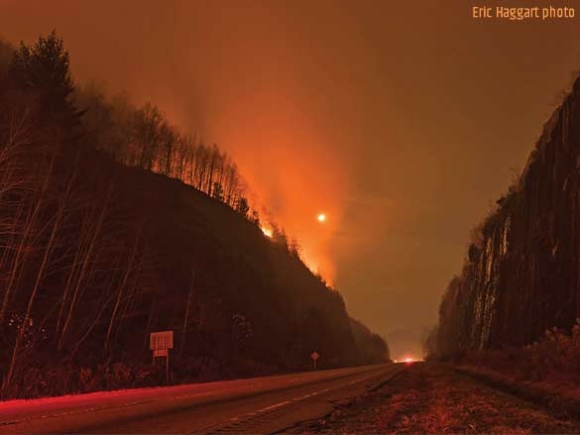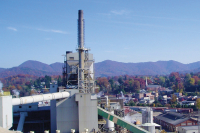As N.C. wildfires slacken, Smokies blaze roars into Gatlinburg

Just as wildfires were beginning to subside in North Carolina, gusty winds whipped a flare-up in the Great Smoky Mountains National Park into a frenzy that climbed down the mountain to enter the town of Gatlinburg and spur forced evacuations around the area.
The Chimney Tops Fire began on Wednesday, Nov. 23, a little 1.5-acre blaze according to the initial press release the park sent out. By Friday, Nov. 25, the fire — at that point a slow-moving affair creeping along the ground — had grown to 3 acres with crews busy building containment lines. As of Sunday morning, Nov. 27, it had reached 10 acres and hovered around 50 by the evening.
And then the winds came.
“The winds that we’ve been experiencing have been sustained at 20 miles per hour, and we’ve had gusts up to 50 miles per hour,” said park spokeswoman Dana Soehn at a press conference Monday afternoon. “We’re expecting those conditions to continue to evolve. We could have gusts up to 80 miles per hour throughout the rest of the day.”
She was right. At the time of the press conference, the fire occupied 500 acres, but winds did nothing but increase as the day progressed and night fell, gusting continually at 50 to 60 miles per hour with the biggest gust clocking in at 87 miles per hour. Fueled by the blowing oxygen, the fire grew. No longer a slowly creeping ground fire, it leapt from tree to tree. Embers blew in the wind, resulting in new spot fires around the main fire.
The fire escaped the park and entered the adjoining town of Gatlinburg, Tennessee.
Related Items
Evacuations were ordered. Homes and businesses were caught in the blaze. No fatalities have been reported, but four people received burn injuries requiring hospital treatment.
As of 9 a.m. Monday morning, the Tennessee Emergency Management Agency was reporting 11,595 people without power in Sevier County, with an estimated 1,100 people occupying four emergency shelters. Evacuations likely displaced more than 14,000 residents and visitors from Gatlinburg alone, not including evacuations in outlying areas and Pigeon Forge.
As of press time on Tuesday, the size of the fire was still unknown. Heavy smoke and gusting wind had made it impossible for helicopters to fly and get a comprehensive sense of the situation.
“Even with the rain that is currently falling there, the fires continue to burn and structures remain engulfed with little hope that the rainfall will bring immediate relief,” reads a TEMA press release.
“We just continually had gusts of 50, 60 mile per hour winds,” said Jamie Sanders, public information officer for the park. “That on top of the exceptional drought conditions made it to where it was able to move the way that it did.”
As of press time, the park was still closed — even employees had to be evacuated at one point on Tuesday — and everyone’s working to get a handle on what the situation is, how best to address it and where the resources should come from.
 “Nobody is out doing anything operational or fighting fire right now,” Kris Eriksen, manager of the U.S. Forest Service’s Joint Information Center in Asheville, said Tuesday morning. “They’re just saving stuff. They’re just trying to get people out of the town, evacuated, get the engines in. There’s things that have to happen before (firefighting) happens. People have to be in radio contact. You have to make sure they’re safe and that you know where everyone is.”
“Nobody is out doing anything operational or fighting fire right now,” Kris Eriksen, manager of the U.S. Forest Service’s Joint Information Center in Asheville, said Tuesday morning. “They’re just saving stuff. They’re just trying to get people out of the town, evacuated, get the engines in. There’s things that have to happen before (firefighting) happens. People have to be in radio contact. You have to make sure they’re safe and that you know where everyone is.”
Help coming from N.C.
One piece of good news is that thousands of firefighters are already deployed in North Carolina, and for many of them the job they’re currently assigned to is wrapping up. Wildfire growth in North Carolina has slowed to a crawl, with changes in acreage of wildfires west of Asheville that had already been reported as of press time Nov. 22 adding up to a net negative, not a net positive. A newer start, the Camp Branch Fire near Franklin, accounts for all the gain in fire size, clocking in at 3,210 acres as of Tuesday morning. At that time it was 55 percent contained with 293 personnel. The fire started Nov. 22.
“Some of the resources that still have time on them that were headed to be sent home are being redirected over to help Tennessee,” Erikson said, adding, “They’re getting things in Tennessee quicker than they would if they had to order them from Oregon.”
The Party Rock Fire near Lake Lure, for example, is now 100 percent contained and continued management is being turned over to local agencies. The fire burned 7,142 acres — 2,489 acres on state park land and 4,653 acres on private land — and cost an estimated $7.65 million to fight.
Many of those firefighters can now head over to Tennessee to assist with the Chimney Tops Fire now igniting Gatlinburg. State and federal agencies have guidelines as to how long a firefighter can work without a day off, so not all firefighters will be able to head there right away. Some will be legally required to take a rest beforehand.
“Tired people don’t make the best judgments, so they’re trying to make sure that nobody gets so exhausted they can’t do a good job,” Eriksen said.
Firefighters working for federal agencies work two-week shifts and can extend to three weeks but must have at least two days off after working 21 in a row. For those already on the scene in the Southern Appalachians, not even the Thanksgiving holiday was cause to stop fighting. The folks stationed in Franklin, for example, ate their Thanksgiving dinner — courtesy of the N.C. Baptist Men’s Association — outdoors at headquarters.
“Turkey and dressing and pumpkin pie, sweet potato pie and green beans and all the regular things you’d normally have for Thanksgiving, except we had it in a tent and away from our families,” said firefighter Bill Beebe.
Things are looking up over in that neck of the woods, Beebe said. Fires are getting pretty well contained, growth has been held to zero and firefighters are even getting some time to start remediation of the areas — covering up the evidence of dug-out fire lines around fires where hot spots are so far inside there’s little worry of them escaping.
The Franklin area saw similar wind gusts to what Gatlinburg and the Smokies experienced, but it certainly didn’t cause the devastation seen over there.
“From my experience, I expect it outpaced them pretty quickly,” Beebe, whose 40-year firefighting career has spanned the country, said of crews near Gatlinburg. “But here we had fire lines around the fire. We had done burnouts and prepared for this coming through and we were more ready for it. Consequently it didn’t cause us as much trouble as it did for those guys over there. They didn’t have a chance to get ready.”
Hoping for rain
Of course, everyone — from Asheville to Gatlinburg and beyond — is keeping a close eye on the forecast, hoping that the promised rain will come and the fires will disappear. But what happens to the fires will depend a great deal on what form the rain takes, how long it sticks around and what the weather is like between showers.
“In Alaska, I saw fires that overwintered even under snow and came out the next spring,” Beebe said. “It’s hard to say the rain will put it out.”
Many of North Carolina’s fires are big ones. Think about a backyard campfire and how much water it can take to even put that out, Eriksen said.
“A lot of these are larger fires that take what we call a ‘season-ending event,’” Eriksen said. “We need snow or we need sustained rain over a long period of time in order to put a fire out.”
However, nobody seems to be able to define what, specifically, “sustained rain” or “long period of time” mean.
“It depends on how the rains come,” Beebe said Tuesday. “If this was all we got, the forest could be burning again tomorrow because it’s windy and it’s sunshiny. If we get rain again tonight and tomorrow, it might change things. But the potential today of a fire coming out is still there.”
Especially, he said, with what firefighters call “one-hour fuels” — grass and leaves that can get soaked and be ready to burn again within the hour.
“Ultimately what we’d love to see is a little bit of rain — like an inch, inch and a half over four to five days. Not 4 inches in one day because the ground can’t absorb that much so then you have flooding and mudslide problems,” Eriksen said.
The current forecast shows what could turn out to be a season-ending amount of rain. But it’s not a guarantee. In the mountains especially, weather forecasting is not an exact science, and the severity of drought gripping the Southeast will require a lot more than a day or two or rain to vanquish.
Then, too, there’s the potential for people to assume that because it rained one night it’s safe to burn again. And that is not the case. Burn bans are still in effect and will continue to be until fire danger falls down to less critical levels.
“We will use the rain to our advantage, but we’re not going to say we’re going to leave because the rain came,” Beebe said. “We’re going to downsize quite a bit, but there is going to be work to do out there.”
Cost of a fire
Preliminary figures are in on the cost of fighting wildfires in North Carolina, and the numbers are high. Arson is suspected in many of the blazes, with tips still sought to determine their origin.
• Boteler Fire: $10.8 million*
• Maple Springs Fire: $6.5 million
• Tellico Fire Fire: $5.4 million
• Dicks Creek Fire: $920,000
• Knob Fire: $203,000
• Camp Branch Fire: $136,000
Total cost of firefighting in North Carolina’s National Forests: $27.7 million
*Figures are current through Nov. 26.









